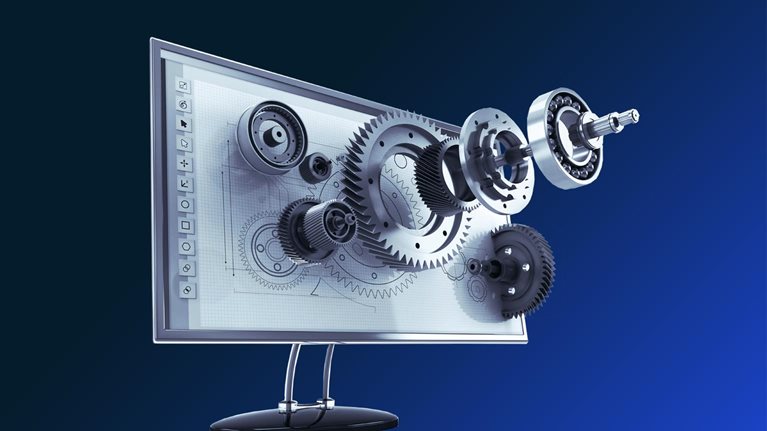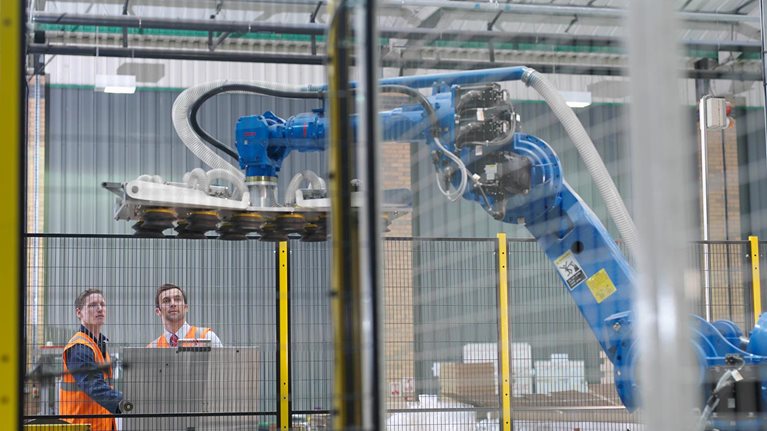Just what is a digital twin? An avatar representing a person or a business in a virtual world? A CAD 1 drawing of a product? A computer algorithm testing the effects of changing one design element on multiple outcomes? Although the term is being heard more frequently, a clear definition can be hard to come by.
This episode of McKinsey Talks Operations—the first in a short series on digital twins—begins our journey into discovering the potential of digital twins by exploring what they are, and also what they are not. The conversation between Kimberly Borden and Anna Herlt, partners in McKinsey’s Operations Practice, is guided by Christian Johnson. The transcript below has been lightly edited for clarity.
Christian Johnson: Your company’s future success demands agile, flexible, and resilient operations. I'm your host, Christian Johnson, and you’re listening to McKinsey Talks Operations, a podcast where the world’s C-suite leaders and McKinsey experts cut through the noise and uncover how to create a new operational reality.
The term digital twin is becoming a lot more common in the business press, but it’s also a bit of a buzzword that often lacks a clear definition. And without that clarity, knowing where and how to use a digital twin—and, even more important, how to capture the potential value—is challenging, to say the least. To help us get under the skin of what a digital twin is and isn’t and to understand how it could help companies across the value chain, I’m delighted to be joined today by two experts in the field: McKinsey partners Anna Herlt, based in our Munich office, and Kimberly Borden in Chicago, who are leaders working with clients to understand the potential and application of digital twins. Kimberly and Anna, thank you for joining us today.
OK, Anna, let’s start with trying to understand a bit more about our subject today. A nice, easy question to kick us off. So, what is a digital twin?
Anna Herlt: Well, Christian, that’s indeed a very good question, and let me try to give you an easy enough answer. A digital twin is actually a digital representation of a physical object—a representation that we always look at in its environment. What’s important is that you link the digital twin with real data sources from the environment and are able to update the twin in real time.
What’s important is that you link the digital twin with real data sources from the environment and are able to update the twin in real time.
Christian Johnson: And, Kimberly, can you say a little bit about the types of digital twins available?
Kimberly Borden: There are common archetypes of digital twins. For example, there’s a product twin, which is a representation of the product; there is a production plant twin, which could be a representation of the entire manufacturing facility; there is a procurement and supply chain twin, often called a network twin; and, finally, there can also be an infrastructure twin.
For a product twin, this can encompass various parts of the product life cycle, all the way from the initial concept design and engineering through to services—meaning that as the product is functioning in service, you are getting live, real-time data on it. An everyday example would be Google Maps, which is a digital twin of the Earth’s surface. It then links real-time data on traffic to optimize your driving routes. That’s a very simplistic version of a digital twin.
Christian Johnson: As I mentioned in the introduction, digital twin is becoming a pretty commonly used term and a bit of a buzzword as well. So, can you also define what a digital twin isn’t? What doesn’t meet the standard?
Kimberly Borden: You’re exactly right, Christian; people use the term very loosely today. For example, some people would call a digital twin a simple simulation or a CAD drawing. That is not actually accurate. A true twin often encompasses multiple physical models and is processing real-time data live.
Christian Johnson: It sounds like it’s at a greater level of precision and accuracy, involving multiple models, and then the link to real-time data seems really important. Is that correct?
Kimberly Borden: Yes, that’s exactly right. The reality is that a true digital twin would also function throughout the product life cycle, meaning all the way from design through service.
Christian Johnson: OK, so it’s much more integrated across the value chain, it sounds like.
Kimberly Borden: That’s correct.
Christian Johnson: And now that we know what’s in the scope of our discussion today, can you say a little bit about the value that companies and organizations can get from digital twins? What can they do for us?
Kimberly Borden: There is a tremendous amount of value a digital twin can bring. One of the biggest areas of value is reducing time to market, development time. It allows for rapid iterations and optimizations of product designs far faster than physically testing every single prototype. Further, it often results in tremendous improvements in product quality, as you can imagine. These can be through the manufacturing process, meaning that after you simulate the product in manufacturing, it’ll allow you to see where there are flaws in the design in order to better manufacture it. Further, in service you can actually see how the design may not be functioning appropriately, and therefore you can redesign it in real time.
Finally, we’ve also seen increases in revenue of as much as 10 percent by developing customer twins that allow customers to fully interact and immerse themselves within the product. Daimler, for example, has done that very nicely to allow customers to test-drive the vehicle ahead of ever getting in a car.
Christian Johnson: Great. Kimberly’s just talked about the results that we can get from digital twins—the increased speed to market, improvements in product quality, increases in revenue. How can those results translate into other major business concerns, such as environmental sustainability?
Anna Herlt: That’s a very good question, and, obviously, sustainability is one of the topics that we discuss a lot these days. And, indeed, a digital twin can be extremely helpful, especially a product digital twin, or a twin that you use in your product development process. It can either help you to reduce the material in your design, so overall material consumption, or you can improve the traceability of the product to reduce quality issues and, ultimately, also reduce waste for our environment. This is an area where consumer electronics manufacturers actually have made significant improvements, and they have reduced scrap by roughly 20 percent.
Christian Johnson: There’s clearly a lot of value available both for companies and for their customers. But as with so many things, the challenge is where to start. What are the necessary conditions for implementing a digital twin?
Anna Herlt: I think one of the key elements that you need to have in place is digital maturity. You need to have the supporting data infrastructures, such as PLM, 2 PDM, 3 and access to high-quality data from testing and from the real data environment, either in manufacturing or in service.
Kimberly Borden: You will also need a suitable use case. Generally, complex or dynamic environments that benefit from real-time optimization are good candidates for an initial use case. That said, there are companies even twinning simple products in order to get real-time customer feedback—for example, toothbrushes or everyday products that people use.
Subscribe to the McKinsey Talks Operations podcast
Christian Johnson: Interesting. Now, one of the things that we’ve spoken about in earlier podcasts—and there’s a lot of coverage in the press as well—is the skills shortage and in particular the digital-skills shortage. Say you’re trying to put this together as a company. What are the skill sets that you’re going to need to have in place to implement a digital twin?
Kimberly Borden: One of the key things you need in place is a strong data infrastructure. Therefore, because of that, you will need data engineering and data science resources in order to support that data infrastructure and put the twin together. Further, you will need to have physical-modeling capabilities to model the product or the facility that you’re trying to twin. And, finally, in complex situations, you will need advanced simulation and analytics skills in order to speed the compute power. As you can imagine, if you are trying to twin a fighter jet, for example, that takes a tremendous amount more computing power than twinning a toothbrush. Overall, a higher level of digital maturity will make it easier for implementation.
Christian Johnson: So, with that in mind, apart from the necessary skills—or rather the lack thereof—that we’ve just talked about for successful implementation, what are other barriers to getting started with digital twins?
Anna Herlt: When we talk to companies, one of the highest barriers is the skills. But another one is clearly the large up-front investment that is required before you really can get to the full value, and then the lack of access to the high-quality data that the twin would actually require.
Kimberly Borden: In addition, it will often require linking to multiple data sources, which takes time and some of those highly skilled resources we were talking about earlier.
Anna Herlt: And then I think many companies need to identify where to start—that is, which is the most relevant use case to start with. And we typically try to pick one that is not too complex and actually build out the entire digital-twin framework from there.
Christian Johnson: That’s great. Thank you. To wrap up our conversation today, can we give our listeners some practical advice? What would you say to someone who wanted to get started in working with digital twins?
Anna Herlt: I think what is very important to get started is really to understand your starting position, right? Conduct something like a digital-maturity assessment to understand your current strengths and weaknesses, whether you really want to start from where you are or what is the infrastructure that you need to build. And then, as I said before, start with a small MVP,4 learn from it, and grow it from there.
Kimberly Borden: In addition, it will be important to have a clearly defined business case that is very obviously tied to value. Make that use case highly specific as you start out. Further, it’s very important to consider the digital twin with respect to your broader digital strategy—considering where it fits in, how you can best use this capability for a competitive advantage in the marketplace. As an example, if you are able, through the twin, to provide better product quality faster than the competition, that is a true competitive advantage and a great candidate for leveraging digital-twin capabilities.
It’s very important to consider the digital twin with respect to your broader digital strategy—considering where it fits in, how you can best use this capability for a competitive advantage in the marketplace.
Christian Johnson: Thank you again, Kimberly and Anna. Really valuable advice about taking a holistic view and making it part of your wider strategy.
Kimberly Borden: Thank you, Christian.
Anna Herlt: Thank you, Christian.
Christian Johnson: We’ve talked a lot today about definitions and basic requirements for digital-twin implementation, but it’s clear that there’s a lot more to be said about digital twins and their uses. We’ll be exploring that more in future episodes. Lots more to say. Thank you, Kim and Anna, for your time today. You’ve been listening to McKinsey Talks Operations with me, Christian Johnson. If you like what you’ve heard, subscribe to our show on Spotify, Apple Podcasts, or wherever you listen.


